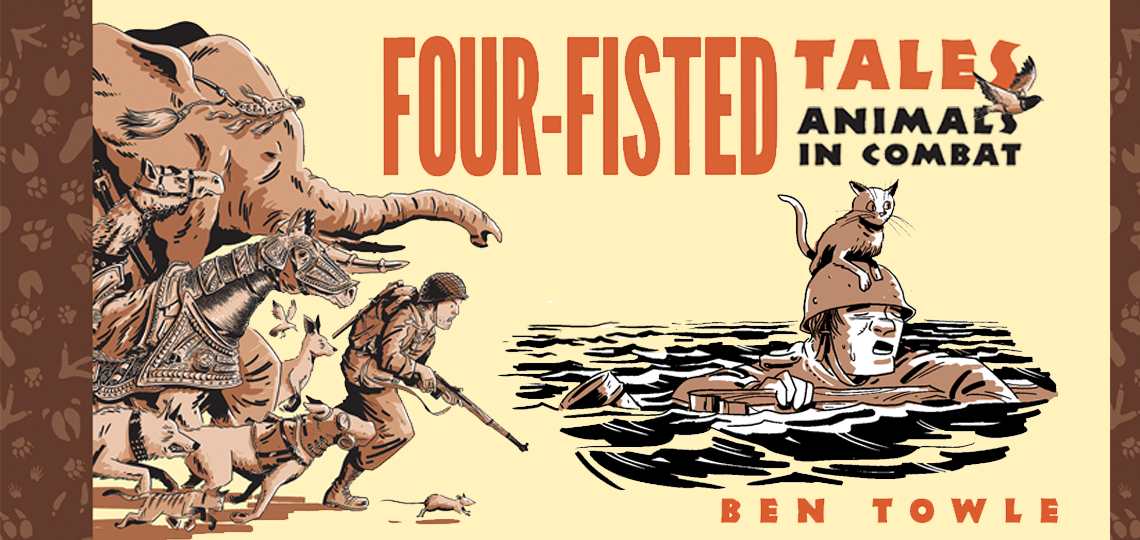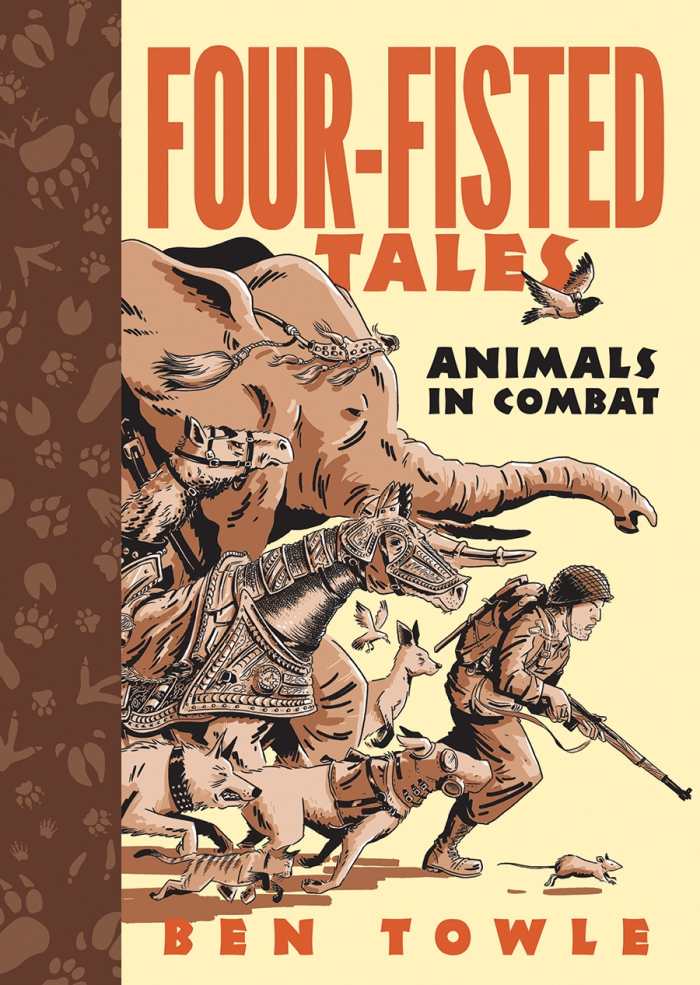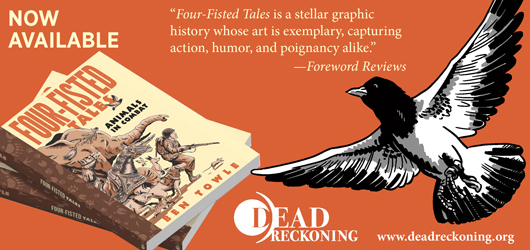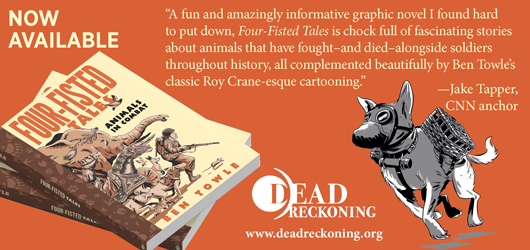"A stellar graphic history whose art is exemplary, capturing action, humor, and poignancy alike." - Foreword Reviews

Reviewer Peter Dabbene Interviews Ben Towle, Author of Four-Fisted Tales: Animals in Combat
What, you thought we outlawed the military draft in this country? For humans maybe, but not if you’re a dog or dolphin, seagull or rat, and lots of other animals. And the poor little things didn’t even get a draft card in the mail to burn.
With the help of Dead Reckoning, we’re excited to connect graphic novel reviewer extraordinaire, Peter Dabbene, with Ben Towle, who wrote and illustrated the delightful story of how animals have been appropriated by militaries around the world to wage war. Ben’s Four-Fisted Tales earned a coveted starred review from Peter in Foreword’s July/August issue, which quickly led to this fascinating conversation.
Enjoy!
How did you get started—first with art and pictorial storytelling, and then the comics industry? Did you always aspire to tell stories with pictures? Take us through your “secret origin.”
Art was always something I was interested in—even from a very young age. That said, art is something pretty much all kids do initially, then there’s a point somewhere at which all but a few give up drawing and move on to other things. I was definitely part of that few, though, who continue on.
As for comics particularly, yes, I read a ton of comics as a kid. Early on it was mostly strip collections—Betty Boop and Little Orphan Annie are two I recall specifically. I also stumbled on the amazing Bill Blackbeard-edited Smithsonian Collection of Newspaper Comics fairly early on and that was a very important comics touchstone for me—particularly the E.C. Segar Popeye stuff, which remains among my favorite comics to this day.
It wasn’t until later, though—maybe early teens—that I really got interested in making my own comics. I became a real devotee of superhero comics (mostly Marvel stuff) after buying one of the early issues of Walt Simonson’s Thor run off a convenience store spinner rack. That’s the point at which you can see in my sketchbooks a definite move toward attempting panel-to-panel storytelling—a pursuit, obviously, that continues to this day.
Four-Fisted Tales: Animals in Combat is a fascinating book about the sometimes strange and unexpected ways that animals have aided humans in war. From this and your past work, it seems that you prefer to tell “real-life” stories that are grounded in historical fact, even if you’re using fictional characters to do so. Were you always a history buff, or are these just the stories that speak to you?
No, interestingly, I’d never had much interest in history prior to getting into comics-making relatively late in life. The one history class I took in college (some sort of Medieval history course) was largely just memorizing and regurgitating things, which I truly loathed. The difference between that and what I wound up doing for my first history-based comics work, Midnight Sun, was the process of investigation and research. I found that I really loved the process of finding out bits and pieces of now largely-forgotten history, whether—in the case of Midnight Sun—it’s an arctic aviation disaster, or (as with Four-Fisted Tales) interesting military animal stories.
Also, I’ve always struggled more with the writing in comics than the drawing, and using historical sources gives one a starting point with the former. Rather than coming up with a story out of whole cloth, you’re rearranging and manipulating pieces of a thing into some sort of (hopefully!) engaging narrative structure. It gives you a starting point.
For example, with the section in Four-Fisted Tales about dolphins, I wound up with lots of interesting bits of information about military dolphins but was having difficulty figuring out a way to put them all together into some sort of narrative that would be enjoyable to read, rather than just a jumble of facts. When I stumbled on a story about a bunch of environmental and animal rights groups taking the Navy to court over its dolphin program, I realized that by setting up the Four-Fisted Tales section on dolphins as a fictionalized story of that trial, I could weave together the history of various military dolphin programs as a part of the testimony being given to the jury during the trial. At that point it then just became an exercise in structuring things narratively.
A confession: I have a weakness for music that does the same sort of thing you’ve done with Four-Fisted Tales; that is, taking historical events and shaping them into a narrative that entertains and educates simultaneously. There are many examples out there, but a song that immediately comes to mind is “Winkie,” a 2016 release by the British band Big Big Train, which tells the tale of an RAF pigeon and her critical role in the rescue of a World War II plane downed at sea. It’s a story you’ve told as part of Four-Fisted Tales, and I’m wondering if you have any favorites of the “history-inspired” musical genre you’d recommend to our readers?
Wow, I’d not heard of that song before and I immediately went out and listened to it!
As far as other history-inspired songs, I don’t have any particular favorites in that specific genre, but I do have sort of a fascination with songs that have a strong root in some particular historical moment or situation, but whose meaning has gotten lost. The most obvious—and pretty egregious—of them currently is “Born in the U.S.A.,” which you hilariously often hear used as if it were some sort of patriotic jingoistic anthem.
More interesting, though, I think are songs like “This Land is Your Land,” by Woodie Guthrie, which was written as a direct (critical) reply to “God Bless America.” Or, more historical than political, things like “London Bridge is Falling Down” and “Waltzing Matilda” which (in the US anyway) are largely thought of as children’s songs, but which both have really interesting historical bents.
Four-Fisted Tales has stories about horses, dogs, and carrier pigeons, as well as mine-detecting rats and dolphins trained to seek out and strike enemy divers. Were there any animals you were expecting (or hoping) to pop up in your research that didn’t? Any animals that haven’t yet played a role in combat, but might one day?
Absolutely. I was very surprised to have turned up virtually no mention of other primates—specifically apes and monkeys–being used in combat. I turned up one or two (highly suspect) stories about gun-wielding monkeys, but that was about it.
Dolphins, as illustrated in Four-Fisted Tales, have been used by various militaries. Like dolphins, monkeys are highly intelligent. Why haven’t we seen much in the way of attempts to utilize them in combat? I’d like to think the reason there hasn’t been much use of these highly-intelligent animals in military applications is that we recognize them as creatures like ourselves that most certainly have feelings, emotions, and agency. Our willingness to use dolphins, though, is a counterpoint to this.
I made a point to not have Four-Fisted Tales beat people over the head with a moral argument about the use of animals in combat, but I hope at the very least that readers will come away from the book with a definite sense that this is a complex and potentially morally troubling issue. I think there’s a certain abstraction to the way animals in wartime are portrayed in a lot of fiction which allows us to celebrate the amazing achievements of these animals without considering the gravity of what we’re doing when we take these creatures and subject them to pain, suffering, and death as if they were objects or property.
With technology solving many of the problems that animals in combat once addressed—communication across long distances or hazardous terrain, security, detection of poisons, etc.—do you think animals will continue to have a role in armed conflicts?
It would be nice to think that the days of humans using animals in wars are over, but I think we’ll still continue to see them employed in various tasks that they’ve historically been used for, just because they’re so darn good at it. Anyone who has a dog, for example, can tell you that they’re pretty solid guards/alarm systems. Simple, cheap to “operate,” trainable, etc. (not to mention, great companion animals).
Whenever I see those viral videos of four-legged robots walking around, I’m—like everyone else—kind of amazed and horrified at the same time, but another part of me always thinks, “We’ve already got things that can do this that are cheap, easy to take care of, and reasonably effective: mules.”
I doubt we’ll see a whole lot of carrier pigeons from here forward, but every once in a while, there are situations where animals can do things far better than any technological solution. A relatively recent example is post-9/11 Afghanistan, where some US Special Forces were operating on horseback—a story that was in consideration for Four-Fisted Tales, but I wound up not doing.
Is there a graphic novel dream project you hope to make happen one day? Something epic, esoteric, or otherwise?
Speaking very broadly, at some point I’d love to do some sort of science fiction story. I read a lot of SF and have been a lifelong fan of classic Star Trek, for example, but I’ve never really done anything SF with comics.
More specifically, though, one of my dream projects is to do a comics adaptation of Alexander Dumas’s The Count of Monte Cristo. I had a full pitch together for it years ago—plot breakdown, character designs, sample pages—but my agent couldn’t find a publisher for it. I’ve had a few nibbles of interest since then, but always with the caveat that there be some “twist” to it, like setting it in modern times, or in a high school or something, and I’m really not interested in that angle. It’s a fantastic story as-is and the historical setting, costuming, etc., would be a huge part of the appeal for me taking on something like that.
Four-Fisted Tales
Animals in Combat

Ben Towle
Dead Reckoning
Softcover $24.95 (120pp)
978-1-68247-416-7
Buy: Local Bookstore (Bookshop)
Ben Towle’s exciting graphic history Four-Fisted Tales covers animals in combat.
Towle reveals that animals have participated in human wars for centuries—sometimes in novel ways. Though covering what’s expected of a book about animals in battle—as with the inclusion of dogs, horses, and carrier pigeons—the book completes its work in fresh, lively style. Unlikely battle participants, including seagulls, rats, and slugs, are featured in active roles, while a chapter on military mascots includes a goat, a baboon, a king penguin, and a pygmy flying phalanger. In eleven sections, the stories of these animals are revealed—most in dramatic vignettes, though some, as with the entry for ships’ cats, are profiled in shorter, caption-centered accounts.
The stories showcase a variety of narrative methods. The tale of Wojtek the Bear is told in six wordless pages, followed by an illustration of a G.I. Joe-style bear action figure, with a caption that provides background on the bear’s service. And the book begins and ends with a group of World War I soldiers who use a jar of glow worms as illumination, so as not to betray their position to their enemies. A courtroom is the setting for an investigation into the supposed military uses of dolphins: locating mines, guarding bases, identifying submarines, and seeking out and injecting enemy divers with compressed nitrogen to cause fatal embolisms.
Four-Fisted Tales is a stellar graphic history whose art is exemplary, capturing action, humor, and poignancy alike. The panels flow together with ease thanks to Towle’s clarity, attention to detail, and eye for accurate, anatomical animal representations.
PETER DABBENE (June 27, 2021)
Peter Dabbene



